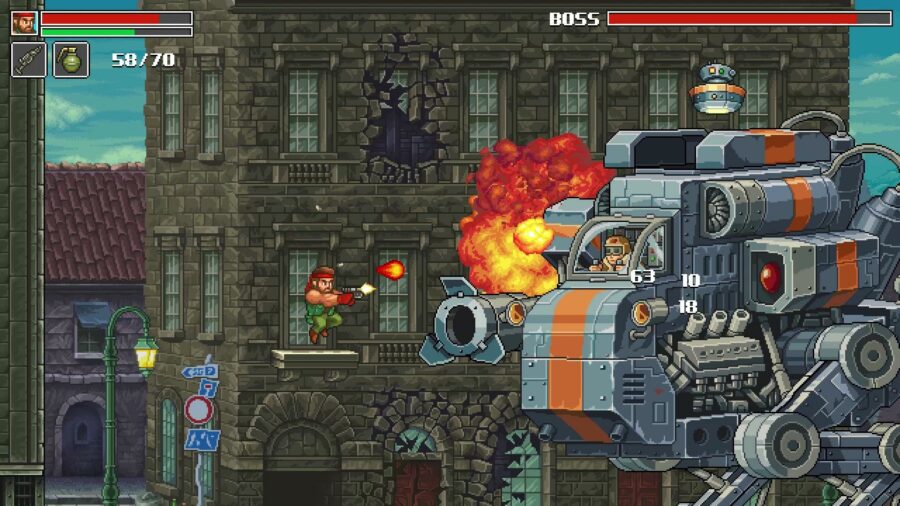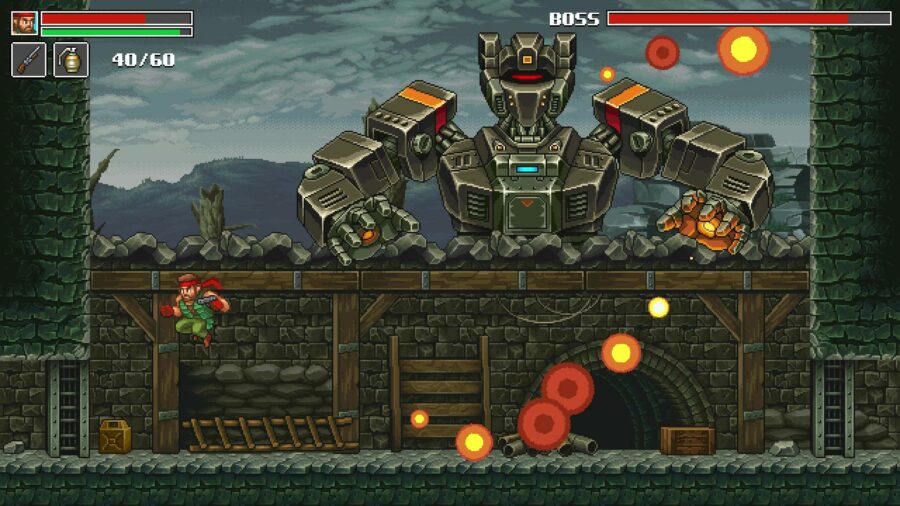There was an argument in some corners of the video game Internet last year about the alleged overuse of yellow paint as an objective marker. This was spurred by several then-recent releases like God of War: Ragnarok, Final Fantasy VII Rebirth, and the Separate Ways DLC for the Resident Evil 4 remake.
The common thread between those games is that they all use yellow paint to indicate that you can interact with a given object, such as a destructible crate or handholds on a climbable wall. Some players thought that was an unnecessary detail, and perhaps even insulting to their intelligence. Some players clearly don’t have enough real problems.
I didn’t think much of that conversation at the time, and still don’t, but I’ve begun to wonder if it had a bigger impact on game development than I thought it would. Guns of Fury is the third game I’ve played recently, after Iron Meat and INAYAH, where part of its challenge is figuring out what parts of its environments are actually meant to be interactive, and I’m not sure how much of that was intended.

Guns is a 2D action/platformer from indie developers John and Lefteris Christodoulatos, who previously created Goblin Sword for iOS and Switch. With Guns, they’ve made a game that has one of the easiest elevator pitches I’ve ever seen: what if Metal Slug, but also Metroid?
Guns is set in the 2040s, when an energy crisis has plunged Earth into open conflict. A scientist named Klaus announces he’s invented a new technology, the Tetra Cell, that could address the planet’s power needs.
Then Klaus is kidnapped by the private research corporation Easton Industries, which plans to weaponize the Tetra Cell. You play as special operative Vincent Fury, who’s sent to Easton Industries’ headquarters to find and retrieve Dr. Klaus, but immediately gets captured. Once you break out of your cell, you’re left alone and unarmed behind enemy lines.
Guns wears its influences on its sleeves from the start. It’s a throwback to both SNK’s Metal Slug series, which is known for both its hardcore action and its hand-drawn, lovingly animated sprites, and the deliberate inaccessibility of the first couple of Metroid games. Guns features a huge, sprawling map full of hazards, enemies, and puzzles, where you often have to think outside the box a little in order to make progress.
That’s something about the first few Metroid games that got lost along the way as the “Metroidvania” genre evolved: they aren’t afraid to frustrate you. Many later games in Metroid’s lane, including Symphony of the Night, feature a comparatively streamlined map design that’s designed to lead you along a specific path. If you hit an obstacle, you know to come back later once you’ve found a way to bypass it. In Metroid, conversely, you’re supposed to laboriously search every tile on every wall for hidden items and secret passages. If you don’t, you’ll eventually hit a hard stop.
Guns is only a little more forgiving than that. It’s got a couple of modern quality-of-life features like an automap, and you can eventually unlock the ability to fast-travel between save points. Even so, there are several points over the course of the game where your progress stops dead unless you solve what amounts to an unlabeled puzzle. One area requires you to destroy a bridge that doesn’t initially appear to be destructible, while another looks like a dead end unless you blow up part of the background to reveal a couple of new platforms, which don’t initially look like you could stand on them at all.
That added a couple of hours to my first run through Guns, as I didn’t initially understand that. It turned out the real problem was that I wasn’t constantly spraying every object in every new room with random gunfire. At this rate, I’m going to get my American citizenship revoked.

The other half of Guns is an absolute love song to the Metal Slug series, complete with weird enemies, sudden ambushes, painstakingly well-animated enemies, and constant fights against crazy Rube Goldberg war machines. It’s a pleasure to run through some of the larger areas with guns blazing, taking out enemy soldiers, tanks, and robots alike with whatever firepower you’ve managed to scrounge up. Every prolonged combat sequence in Guns’ open world feels like the last 20 minutes of Commando.
Guns saves most of its challenge for its boss fights. Most of them involve a sudden genre shift into bullet hell, as most bosses can fill the screen with several different waves of death. The first trick is figuring out how to survive; the second is finding an opening in which to safely return fire.
That being said, if all you want to do is beat the game, you can face-tank every boss by bringing a full inventory of food and medicine with you. Whenever you take a hit, just pause the game to jam 3 pizzas down Vincent’s throat. If you’re looking for a truly hardcore experience, Guns can deliver that, but you’ll have to set some restrictions for yourself first.
Guns of Fury is the latest indie game that might be a little too lavishly animated for its own good, with a few points of unnecessary visual confusion. Beyond that, however, it’s a crazy ‘80s action movie in video game format, with tons of surprises, a gift for well-paced fight scenes, a bigger map than I expected, and some of the best sprite work I’ve seen in years. It’s worth your time.
[Guns of Fury, published and developed by Gelato Games, is now available for Nintendo Switch and PC via Steam for $14.99. This column was written using a Steam copy of the game purchased by Hard Drive.]



